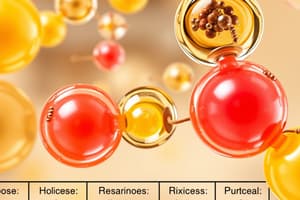Podcast
Questions and Answers
What is produced when fats undergo alkaline hydrolysis?
What is produced when fats undergo alkaline hydrolysis?
- Margarine and water
- Glycerol and soap (correct)
- Alcohol and fat-free acids
- Fatty acids and hydrogen
What type of soap is produced by hydrolysis using Sodium Hydroxide?
What type of soap is produced by hydrolysis using Sodium Hydroxide?
- Soft soap
- Liquid soap
- Glycerin soap
- Hard soap (correct)
Which catalyst is commonly used in the hydrogenation process of converting oils to solid fats?
Which catalyst is commonly used in the hydrogenation process of converting oils to solid fats?
- Copper sulfate
- Zinc oxide
- Iron oxide
- Nickel (correct)
What is the primary function of soap molecules in solution?
What is the primary function of soap molecules in solution?
What is a common application of soap in daily use?
What is a common application of soap in daily use?
Which process describes the conversion of liquid oils into semi-solid fats?
Which process describes the conversion of liquid oils into semi-solid fats?
Which type of hydrolysis involves the use of enzymes?
Which type of hydrolysis involves the use of enzymes?
What is the effect of hydrogenation on the structure of fatty acids in oils?
What is the effect of hydrogenation on the structure of fatty acids in oils?
What is the primary reason for the yellow color of butter?
What is the primary reason for the yellow color of butter?
What process forms ester bonds in fats?
What process forms ester bonds in fats?
How are triglycerides primarily formed?
How are triglycerides primarily formed?
Which of the following best describes the shape of a triglyceride molecule?
Which of the following best describes the shape of a triglyceride molecule?
What causes the rancidity in unsaturated fatty acids when exposed to light and moisture?
What causes the rancidity in unsaturated fatty acids when exposed to light and moisture?
What classification of fatty acids is determined by the number of double bonds in their carbon chain?
What classification of fatty acids is determined by the number of double bonds in their carbon chain?
Which of the following fatty acids do not get rancid?
Which of the following fatty acids do not get rancid?
What occurs during the esterification process?
What occurs during the esterification process?
What is one method used to prevent rancification in fats and oils?
What is one method used to prevent rancification in fats and oils?
What factor primarily influences the melting point of fatty acids?
What factor primarily influences the melting point of fatty acids?
What is the main product formed during the enzymatic hydrolytic rancification of fats?
What is the main product formed during the enzymatic hydrolytic rancification of fats?
What role do emulsifiers play in the formation of emulsions with fats?
What role do emulsifiers play in the formation of emulsions with fats?
Which of the following oils is classified as a drying oil?
Which of the following oils is classified as a drying oil?
What is the result of the oxidation and polymerization of highly unsaturated oils?
What is the result of the oxidation and polymerization of highly unsaturated oils?
During the process of drying oils, what initiates the crosslinking reaction?
During the process of drying oils, what initiates the crosslinking reaction?
Which compound is primarily responsible for the unpleasant odor in rancid butter?
Which compound is primarily responsible for the unpleasant odor in rancid butter?
What does a higher saponification value indicate about the fats being analyzed?
What does a higher saponification value indicate about the fats being analyzed?
What is the purpose of using phenolphthalein solution in the saponification procedure?
What is the purpose of using phenolphthalein solution in the saponification procedure?
How is the ester value calculated?
How is the ester value calculated?
What is the significance of the iodine value in fat analysis?
What is the significance of the iodine value in fat analysis?
What is the correct molar concentration used in the titration for determining saponification value?
What is the correct molar concentration used in the titration for determining saponification value?
Which of the following fats has the highest saponification value?
Which of the following fats has the highest saponification value?
In the saponification value equation, what does 'W' represent?
In the saponification value equation, what does 'W' represent?
What is primarily detected using the saponification value?
What is primarily detected using the saponification value?
What is the first step in Hubl's method for determining iodine value?
What is the first step in Hubl's method for determining iodine value?
In Wij's method, what role does acetic acid play?
In Wij's method, what role does acetic acid play?
How is the unreacted iodine calculated in Wij's method?
How is the unreacted iodine calculated in Wij's method?
What does the iodine value indicate about a fat or oil?
What does the iodine value indicate about a fat or oil?
What effect does a higher iodine value have on fats or oils?
What effect does a higher iodine value have on fats or oils?
Which variable in the iodine value equation represents the weight of the fat or oil taken?
Which variable in the iodine value equation represents the weight of the fat or oil taken?
What does 'b' represent in the iodine value formula?
What does 'b' represent in the iodine value formula?
Which of the following methods uses iodine monochloride as a key component?
Which of the following methods uses iodine monochloride as a key component?
Flashcards are hidden until you start studying
Study Notes
Fats and Oils
- Fats and oils are esters of fatty acids and glycerol.
- They are readily emulsified in water with the addition of soap, gelation, or emulsifiers.
- The yellow color of butter is due to carotene and the taste is due to diacetyl and 3-hydroxy-2-butanone.
Chemical Structure of Fats and Oils
- Most fats are glycerides, particularly triglycerides.
- Each glycerol molecule is bonded to three fatty acid chains through esterification.
- The properties of fats depend on the specific fatty acids present.
Fatty Acids
- Fatty acids are classified based on the number of double bonds in their carbon chain.
- They are composed of a chain of carbon atoms linked in a zig-zag pattern.
- Long fatty acid chains have higher melting points due to stronger van der Waals forces.
Hydrolysis of Fats and Oils
- Hydrolysis of fats and oils with a base (KOH/NaOH) produces soap, a process known as saponification.
- Saponification is the reaction between an ester and a base to form a soap and an alcohol.
- Hydrolysis can also be achieved by heating fat with water under pressure or by using enzymes like lipase.
- The cleansing properties of soap are attributable to its ability to form an emulsion with fat-soluble materials.
Applications of Fats and Oils
- They are used in fire extinguishers.
- They act as cleansing and lubricating agents in laundry.
Hydrogenation of Fats and Oils
- Oils are converted to solid fats by hydrogenation, which is the addition of hydrogen to unsaturated fats. This process is also known as hardening of oils.
- Nickel catalysts are used in hydrogenation.
- Oils containing unsaturated fatty acids are more likely to becoming rancid.
Rancidity in Fats and Oils
- Oils become rancid due to oxidation of unsaturated fatty acids by air, exposure to light and moisture, and enzymatic hydrolysis by microorganisms.
- Rancidity results in the formation of aldehydes, leading to unpleasant odor and taste.
- Saturated fatty acids do not become rancid easily.
- Antioxidants are added to prevent rancidity.
Drying Oils (Polymerization)
- Drying oils contain high percentages of polyunsaturated acids.
- They undergo oxidation and polymerization when exposed to air, forming a thin, waterproof film.
- This process is called drying and is important in the production of oil paints and varnishes.
- Examples of drying oils include linseed oil, tung oil, poppy seed oil, perilla oil, and walnut oil.
Saponification Value
- It is a measure of the number of milligrams of potassium hydroxide required to saponify 1 g of fat or oil.
- It is calculated using the equation: Saponification Number = 168000/M (where M is the molecular weight of the fat).
- High saponification values indicate a high concentration of short-chain fatty acids.
Ester Value
- It represents the number of milligrams of potassium hydroxide required to react with the esters present in 1 g of fat or oil.
- It is calculated by subtracting the acid value from the saponification value.
- It indicates the number of hydroxyl groups in the fat.
Iodine Value
- It measures the degree of unsaturation in a fat or oil.
- Higher iodine values indicate a higher content of unsaturated fatty acids.
- It is determined using various methods, including the Hubl's method and the Wij's method.
- Iodine value is calculated as: Iodine value = 1.269 × (b-a)/W (where W is the weight of the fat or oil, b is the reading of the actual titration, and a is the reading of the blank titration).
Studying That Suits You
Use AI to generate personalized quizzes and flashcards to suit your learning preferences.




